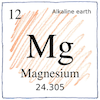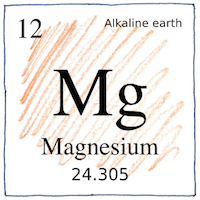Glasgow, London—Joseph Black, Humphry Davy
elements

|
Magnesium
Joseph Black recognized that magnesia alba contained a new element in the line of alkaline earths like calcium as he reported in 1755 his chemical experiments with various alkaline earths combining with acids and carbon dioxide. Humphry Davy was the first to isolate it as a metal. He obtained it using electrolysis of magnesia and mercuric oxide with the Royal Society’s voltaic pile.
Atomic number 12
Alchemists used magnesia alba. The name derived from Magnesia, in Greece, which derived from the tribe, Magnetes, which in turn derived from the legendary Greek hero, Magnes. Epsom salts were naturally occurring— hydrated magnesium sulfate from a spring discovered by a farmer in Epsom, England— and was found to have healing effects. * Magnesium is the lightest structural metal, alloyed with aluminum or zinc, used in aircraft and aerospace components. Automobile parts, laptops, mobile phones, golf clubs, and photoengraving plates are made with it. * Magnesium ribbon or powder is highly explosive, burning bright with ultraviolet light that can damage the eyes, but magnesium phosphate makes wood fireproof.
Stuff that burns
Wood burns, paper burns. If we don’t expect a metal to burn, then we don’t understand burning. Or like burning ears, or a heart burning with love, we understand it only metaphorically.



Joseph Black discovered carbon dioxide, which he called fixed air or just air. He wrote, “It is therefore probable, that, had we also a method of separating the fixed alkali from an acid, without, at the same time, saturating it with air, we should then obtain it in a caustic form; but I am not acquainted with an instance of this separation in chemistry.” It took another 53 years and the invention of the electric battery for Davy to use electrolysis to separate the metal from magnesium oxide.
The invention of magnesium flash powder in 1887 let Jacob Riis photograph the dark side of New York City.
See also in The book of science:
Readings in wikipedia:
Other readings: